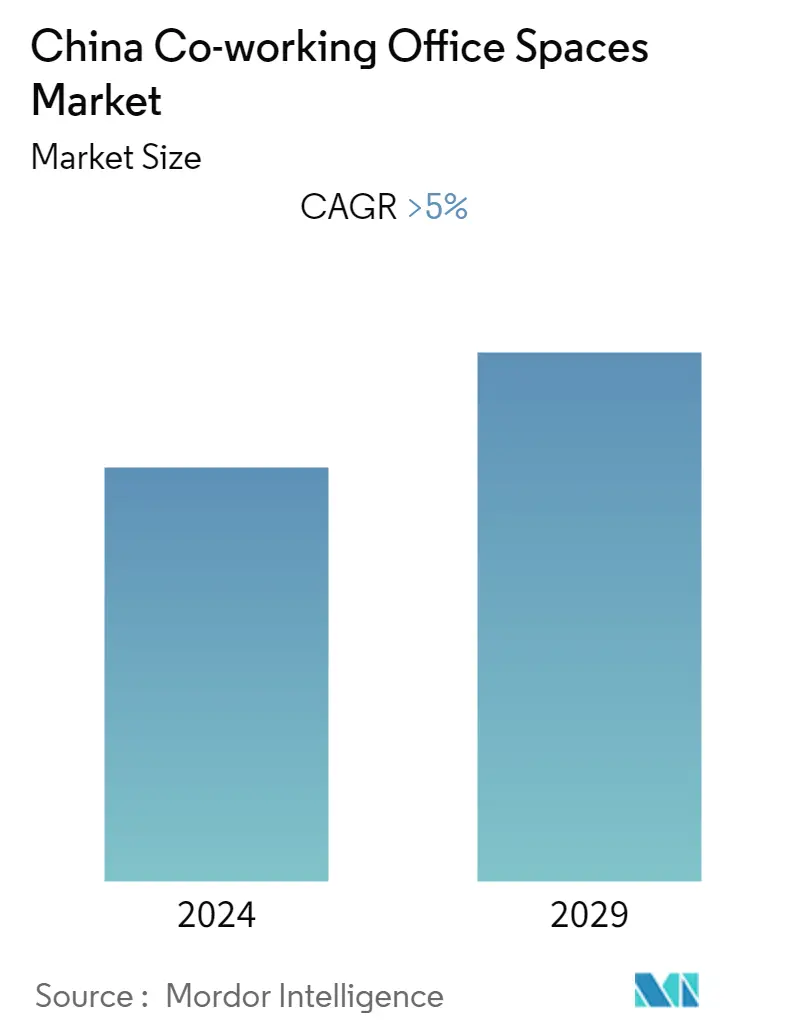Market Size of China Co-working Office Spaces Industry

| Study Period | 2019 - 2029 |
| Base Year For Estimation | 2023 |
| Forecast Data Period | 2024 - 2029 |
| Historical Data Period | 2019 - 2022 |
| CAGR | 5.00 % |
| Market Concentration | Medium |
Major Players
*Disclaimer: Major Players sorted in no particular order |
China Co-Working Office Space Market Analysis
The Chinese Co-working Office Spaces Market is anticipated to record a CAGR of more than 5% during the forecast period.
- The COVID-19 pandemic accelerated the growth of co-working spaces in the country, as traditional workspaces faced challenges during the crisis. Many enterprises moved toward co-working spaces because of the affordable prices and flexibility. The co-working spaces provided a safe working environment.
- The sector is driven by increasing demand from small and medium enterprises (SMEs), freelancers, and start-ups. Large-scale enterprises are also adopting co-working spaces due to their benefits, such as top facilities at affordable prices-also, the increasing number of start-ups with a high investment flow rate results in robust sector growth.
- More mainland Chinese landlords are expected to enter Hong Kong's flexible working space, which has historically been controlled by domestic and foreign investors because it provides a low-risk entry point into the larger office market. China Resources, a mainland-based company, built the CRB Business Lounge in Wan Chai in October, providing 24-hour access to fully furnished, flexible workspaces. Landlord-operated co-working spaces have been controlled by big local operators such as Hongkong Land, Great Eagle Holdings, Swire Properties, and Henderson Land Development. Moreover, China has more than 300 co-working offices contributing 1.48% to the global share of the co-working office spaces market.
China Co-Working Office Space Industry Segmentation
Co-working spaces refer to working arrangements where people from different teams and companies work in a shared space. A co-working space is characterized by shared facilities, services, and tools. Co-working is an arrangement in which workers of different companies share an office space, allowing cost savings and convenience using common infrastructures.
The China co-working office spaces market is segmented by type (flexible managed office and serviced office), application information technology (IT and ITES), legal services, BFSI (Banking, Financial Services, and Insurance), consulting, and other services), by end-user (personal user, small scale company, large scale company, and other end users), by geography (Shanghai, Beijing, Wuhan, and other key cities). The report offers market size and forecasts in value (USD billion) for all the above segments.
| By Type | |
| Flexible Managed Office | |
| Serviced Office |
| By Applications | |
| Information Technology (IT and ITES) | |
| Legal Services | |
| Consulting | |
| BFSI (Banking, Financial Services, and Insurance) |
| By End User | |
| Personal User | |
| Small-scale Company | |
| Large-scale Company |
| By Geography | |
| Shanghai | |
| Beijing | |
| Wuhan |
China Co-working Office Spaces Market Size Summary
The co-working office space market in China is experiencing significant growth, driven by the increasing demand from small and medium enterprises, freelancers, and start-ups. The COVID-19 pandemic has accelerated this trend as traditional workspaces faced challenges, prompting many businesses to seek the flexibility and affordability offered by co-working spaces. These spaces provide a safe and modern working environment, attracting a diverse range of tenants, including large-scale enterprises. The market is characterized by the entry of more mainland Chinese landlords into Hong Kong's flexible working space sector, which has traditionally been dominated by domestic and foreign investors. This expansion is facilitated by the low-risk nature of co-working spaces as a gateway into the larger office market.
The Chinese co-working office space market is moderately fragmented, with both international and national players competing for market share. The presence of millennials, who are reshaping work culture and demanding more flexible working conditions, is a significant factor in the market's growth. Co-working spaces offer urban and stylish environments that cater to this demographic's preferences for freedom and flexibility. The market is witnessing a boom, with new players entering and established companies focusing on expansion and mergers and acquisitions. Prominent players such as WeWork, Regus, and Ucommune are actively expanding their presence, contributing to the competitive landscape of the rapidly growing market.
China Co-working Office Spaces Market Size - Table of Contents
-
1. MARKET INSIGHTS AND DYNAMICS
-
1.1 Market Overview
-
1.2 Market Drivers
-
1.3 Market Restraints
-
1.4 Value Chain / Supply Chain Analysis
-
1.5 Industry Attractiveness - Porter's Five Force Analysis
-
1.5.1 Threat of New Entrants
-
1.5.2 Bargaining Power of Buyers/Consumers
-
1.5.3 Bargaining Power of Suppliers
-
1.5.4 Threat of Substitute Products
-
1.5.5 Intensity of Competitive Rivalry
-
-
1.6 Government Regulations and Initiatives
-
1.7 Technological Trends
-
1.8 Brief on Rental Analysis of Flexible Office Spaces
-
1.9 Insights on Co-working Start-ups in China
-
1.10 Impact of COVID-19 on the Market
-
-
2. MARKET SEGMENTATION
-
2.1 By Type
-
2.1.1 Flexible Managed Office
-
2.1.2 Serviced Office
-
-
2.2 By Applications
-
2.2.1 Information Technology (IT and ITES)
-
2.2.2 Legal Services
-
2.2.3 Consulting
-
2.2.4 BFSI (Banking, Financial Services, and Insurance)
-
-
2.3 By End User
-
2.3.1 Personal User
-
2.3.2 Small-scale Company
-
2.3.3 Large-scale Company
-
-
2.4 By Geography
-
2.4.1 Shanghai
-
2.4.2 Beijing
-
2.4.3 Wuhan
-
-
China Co-working Office Spaces Market Size FAQs
What is the current China Co-working Office Spaces Market size?
The China Co-working Office Spaces Market is projected to register a CAGR of greater than 5% during the forecast period (2024-2029)
Who are the key players in China Co-working Office Spaces Market?
CoWorker, WeWork, ServCorp, Regus and People Squared are the major companies operating in the China Co-working Office Spaces Market.

